If you’re considering outsourcing your SDR function, it’s probably not your first rodeo.
Maybe your in-house team isn’t producing enough pipeline. Maybe you’ve tried hiring SDRs internally, only to deal with long ramp times, poor fit, or high churn. Or maybe you’ve already outsourced before—only to end up with a bloated list of unqualified leads and a sales team that’s lost all faith in the handoffs.
Whatever brought you here, you’re likely asking the same question we hear from most growth-focused teams:
“Which SDR outsourcing companies actually deliver qualified meetings—and how do we avoid wasting time and budget on the wrong ones?”
This article answers that. We’re going to break down:
What actually separates a good SDR partner from a bad one (it’s not just about volume)
A framework for evaluating SDR firms based on your stage and goals
A curated list of vetted providers—no fluff, no affiliate links
And key questions you need to ask before signing a contract
If you want a pipeline partner—not just another agency that floods your CRM with noise—keep reading.
Note: If you’re looking for a partner that fills your calendar with sales-qualified meetings backed with a guarantee, SocialBloom is here to help. We’ll handle everything from end to end and you’ll only be notified when there’s a meeting. Book a consultation now.
The real cost of a bad SDR partner
Outsourcing SDR work can either be a growth multiplier—or a silent pipeline killer.
When the wrong firm is running point on your outbound, the damage doesn’t just show up in weak lead volume. It shows up in burned prospects, missed revenue, and wasted time you can’t get back.
Here’s what we mean:
1. You burn through budget without real pipeline
Plenty of SDR vendors promise a certain number of leads or meetings per month. But once you dig into the actual results, you realize most of those “leads” aren’t qualified, aren’t ICP, or never even showed up.
You’ve paid for motion, not progress. And that’s expensive—especially if it took your team 3–6 months to realize it.
2. You damage your reputation in the market
An SDR firm that doesn’t understand your brand voice or value prop is a liability. Think generic scripts, poorly researched emails, and spammy follow-ups that make your company look desperate or out of touch.
It only takes a few bad touches for a high-value prospect to write you off—for good.
3. Your internal team loses trust (and morale)
When Sales sees junk leads coming in from outsourced SDRs, they stop following up. When Marketing sees pipeline stall despite rising outbound spend, they get blamed. And leadership ends up questioning whether outbound is even worth doing.
Bad outsourcing doesn’t just hurt performance—it erodes alignment across your go-to-market teams.
Red flags to watch out for:
Guaranteed lead volumes without qualification filters: If they’re promising 50 meetings a month but can’t tell you how they screen for ICP, run.
No visibility into messaging or process: SDR work isn’t magic. If you’re locked out of email templates, targeting logic, or CRM reporting, assume the worst.
One-size-fits-all approach: Your ICP, sales cycle, and brand voice are unique. If they’re not asking deep discovery questions early, they’re not customizing.
No feedback loops or performance reviews: A good SDR partner iterates constantly. If you’re not having regular check-ins or seeing strategy updates, they’re probably coasting.
How to evaluate SDR outsourcing companies
When most companies look at SDR vendors, they focus on surface-level questions: How many meetings can you book? What’s your pricing model? How fast can we get started?
But that’s not enough.
If you want an SDR partner who can actually drive qualified pipeline—not just hit activity metrics—you need a deeper evaluation framework. One that cuts through the sales pitch and reveals whether they can really plug into your go-to-market engine.
Here’s what to look for (and why it matters):
First: do they truly understand your business and target market?
This seems obvious, but it’s the single most common failure point in SDR outsourcing. Most vendors take a cookie-cutter approach: they copy-paste messaging from other clients, use generic outbound scripts, and chase meetings with anyone who replies.
The result? Meetings that sound good on paper, but go nowhere in real life—because they’re not aligned with your ICP, buying committee, or sales motion.
A strong SDR partner should push to deeply understand your business from day one. Not just your product or pricing, but your positioning, your competitive landscape, your current sales challenges, and how your buyers actually make decisions.
If you sell a complex B2B SaaS solution to mid-market IT leaders, your SDR partner needs to speak that language. They should know what pain points resonate, what titles to target, what objections to expect, and how to tee up prospects so your AEs can hit the ground running—not spend 15 minutes requalifying every call.
In short: they should feel like an extension of your team, not a third-party call center.
Second: are they transparent about how they work?
Transparency isn’t a nice-to-have. It’s critical.
One of the biggest risks with SDR outsourcing is operating in a black box. You get leads, but you don’t know how they were sourced, what messaging was used, what tools were involved, or whether they’re repeatable.
A trustworthy partner should give you clear visibility into every part of their process. That includes how they build prospect lists, what email copy and call scripts they’re using, how they score leads, and how they handle objections. You should be able to see performance metrics (opens, replies, meetings, no-shows, conversion to opportunities) at a granular level.
Even more importantly, they should invite feedback—and act on it. The best SDR firms don’t just report on what’s happening; they collaborate with your team to make it better. They come to the table with insights, hypotheses, and tests to improve targeting or messaging, not just excuses when things underperform.
If they hesitate to show you what’s under the hood, that’s a red flag. SDR is not a “set it and forget it” function—it’s iterative, and transparency is the only way to improve it.
Third: can they prove they’ve done this in your industry (or a similar one)?
Every SDR firm will say they’re experienced. What you want is proof.
Ask them: Who have you worked with that sells something like us? What were the results? Can you show me messaging samples, campaign strategies, or performance benchmarks from that engagement?
You’re not looking for broad platitudes like “we help B2B companies grow.” You want to know if they’ve built outbound strategies that actually generated qualified meetings for companies with similar sales cycles, ACVs, and personas.
A firm that’s used to selling $10/month SaaS tools to solopreneurs is going to struggle with a $50k enterprise sale that requires targeting CFOs. The sales motion, messaging complexity, and buyer psychology are completely different.
If they don’t have case studies or client references that align with your world, they may still be worth considering—but only if they show a deep willingness to learn and adapt. Experience isn’t everything, but it dramatically reduces the ramp time and trial-and-error phase.
Finally: how adaptable are they as you grow?
Outsourcing your SDR function is rarely a one-size-fits-all engagement. What you need at $2M ARR is very different from what you’ll need at $10M.
Early on, you might just want 5–10 qualified meetings per month. But as you scale, you’ll likely want to test new verticals, expand geos, integrate with your RevOps stack, or even bring some of the function in-house. Your partner needs to grow with you—not hold you back.
That means asking hard questions up front: Can they ramp up or down quickly? Do they offer partial or hybrid models? How do they adapt when messaging or strategy shifts? What happens if you want to shift focus to a new market segment?
Flexibility also shows up in how they handle feedback. The best firms don’t get defensive when you challenge a strategy—they get curious. They see iteration as part of the job, not a disruption.
You’re not just choosing a vendor for the next quarter. You’re (ideally) picking a long-term partner. Look for one that’s built for the long game.
Note: If you’re looking for a partner that fills your calendar with sales-qualified meetings backed with a guarantee, SocialBloom is here to help. We’ll handle everything from end to end and you’ll only be notified when there’s a meeting. Book a consultation now.
Top SDR outsourcing companies and their strengths
Outsourcing SDRs isn’t just about offloading cold outreach. It’s about bringing in a partner who can function like an extension of your sales team—who understands your ICP, aligns with your go-to-market motion, and consistently delivers meetings your AEs actually want to take.
But not all providers are created equal. Some excel at high-touch strategic partnerships. Others win on cost and speed. And some look great on paper but fall apart under scrutiny.
Below is a closer look at five SDR outsourcing firms worth knowing—what they do well, where they might fall short, and which type of company each is best suited for.
SocialBloom: The best SDR outsourcing partner for companies that demand outcomes, not excuses
Most SDR outsourcing companies talk about how many emails they can send, how many tools they can plug in, or how “AI-powered” their workflows are. But when it comes to the metric that actually matters — qualified meetings booked with buyers who want to talk — things get suspiciously quiet.
That’s exactly why SocialBloom exists. For more insights and tips, visit our Blog.
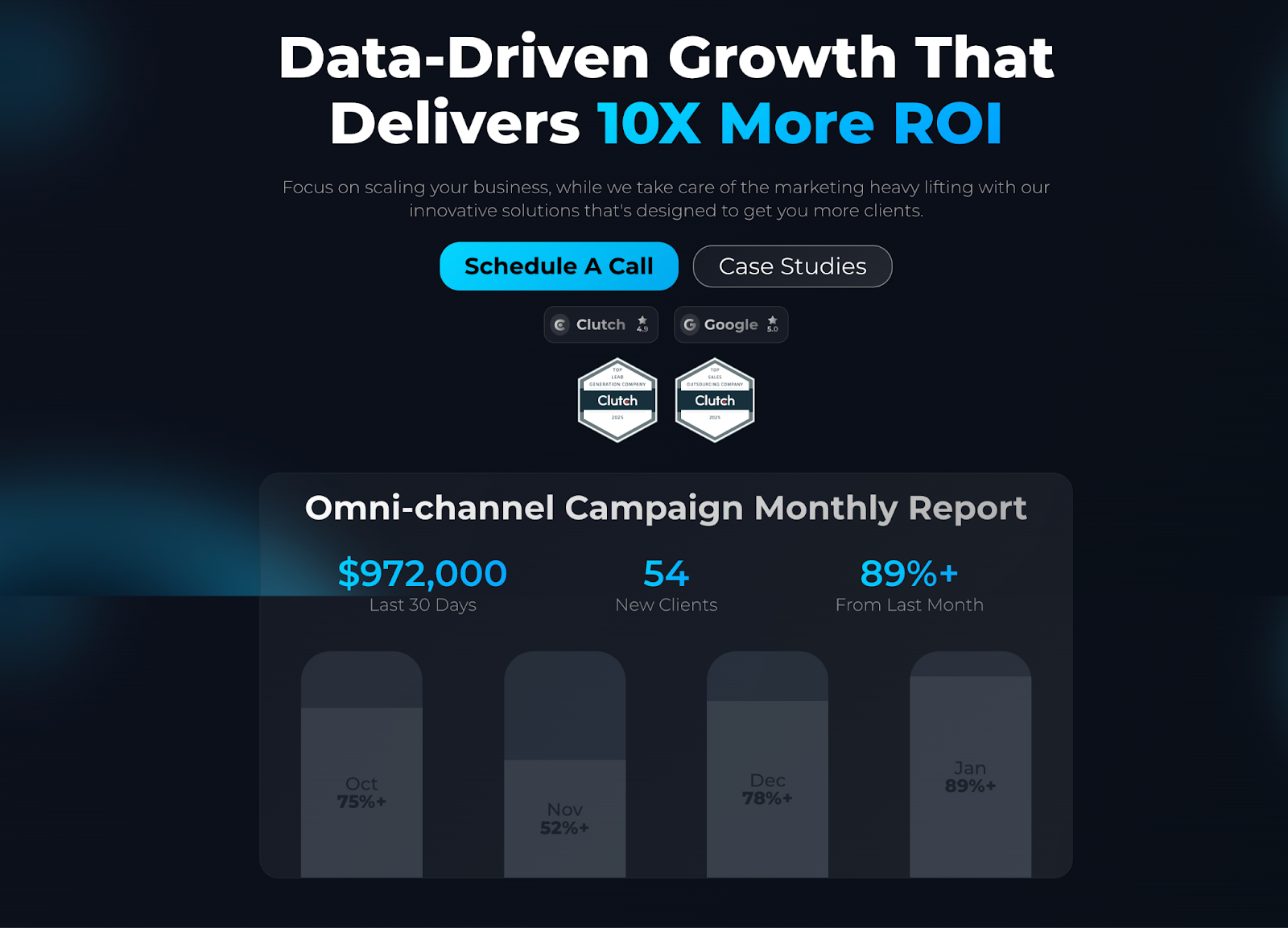
We’re not an agency built around dashboards or tech stacks. We’re built around one thing: owning the outcome. That means consistently filling your calendar with meetings that turn into pipeline — and doing it with a level of strategic precision and execution most agencies don’t even understand, let alone offer.
If you’ve worked with a traditional lead gen vendor before, chances are you’ve already seen the typical playbook:
A few onboarding calls
A high-level ICP slide deck
A vague “go-live” email
Then 6 weeks of silence while they crank out thousands of low-quality emails and celebrate a 3% open rate
At SocialBloom, we do things differently — because we actually know what it takes to make outbound work in 2025.
Why most outbound agencies fail (and where we outperform)
The majority of outbound vendors operate like task machines. They optimize for output — how many messages they can send, how fast they can build a list, how many sequences they can automate.
But outbound isn’t a task. It’s a sales motion.
It demands market insight, compelling offers, buyer psychology, timing, technical setup, and a feedback loop that’s always learning and improving. That’s the gap where most agencies break — and where SocialBloom thrives.
We don’t treat outbound like a checklist. We treat it like a high-performance acquisition channel.
Our team isn’t made up of interns running Zapier automations and hoping for the best. We come from real growth, sales, and demand gen backgrounds. We’ve built outbound engines from scratch. We’ve fixed broken ones. We’ve lived the reality of revenue pressure — and we know what it takes to hit numbers.
What makes our approach work
At the heart of SocialBloom is a simple belief: outbound only works when you align the right message, with the right offer, to the right person — at the right time.
We’ve engineered our process to make that alignment inevitable.
1. We start with strategy, not tools
While most agencies fire up Clay or Instantly in week one, we do a deep diagnostic. We get inside your offer, your ICP, your differentiation, and the psychology of your buyer. We ask hard questions most vendors skip:
What is the actual value you deliver?
Why should someone choose you over your top competitor?
What’s happening in your customer’s world that makes your offer urgent?
What makes your sales conversations close?
Until we can answer those clearly — in the buyer’s language — we don’t touch a tool. Because a cold email campaign without this foundation is just noise at scale.
2. We build lists manually before enriching with Clay
Clay is powerful — but only when used correctly. Most agencies use Clay to build lists from scratch, relying on vague filters and unverified sources. The result? Garbage data, bad matches, and wasted time.
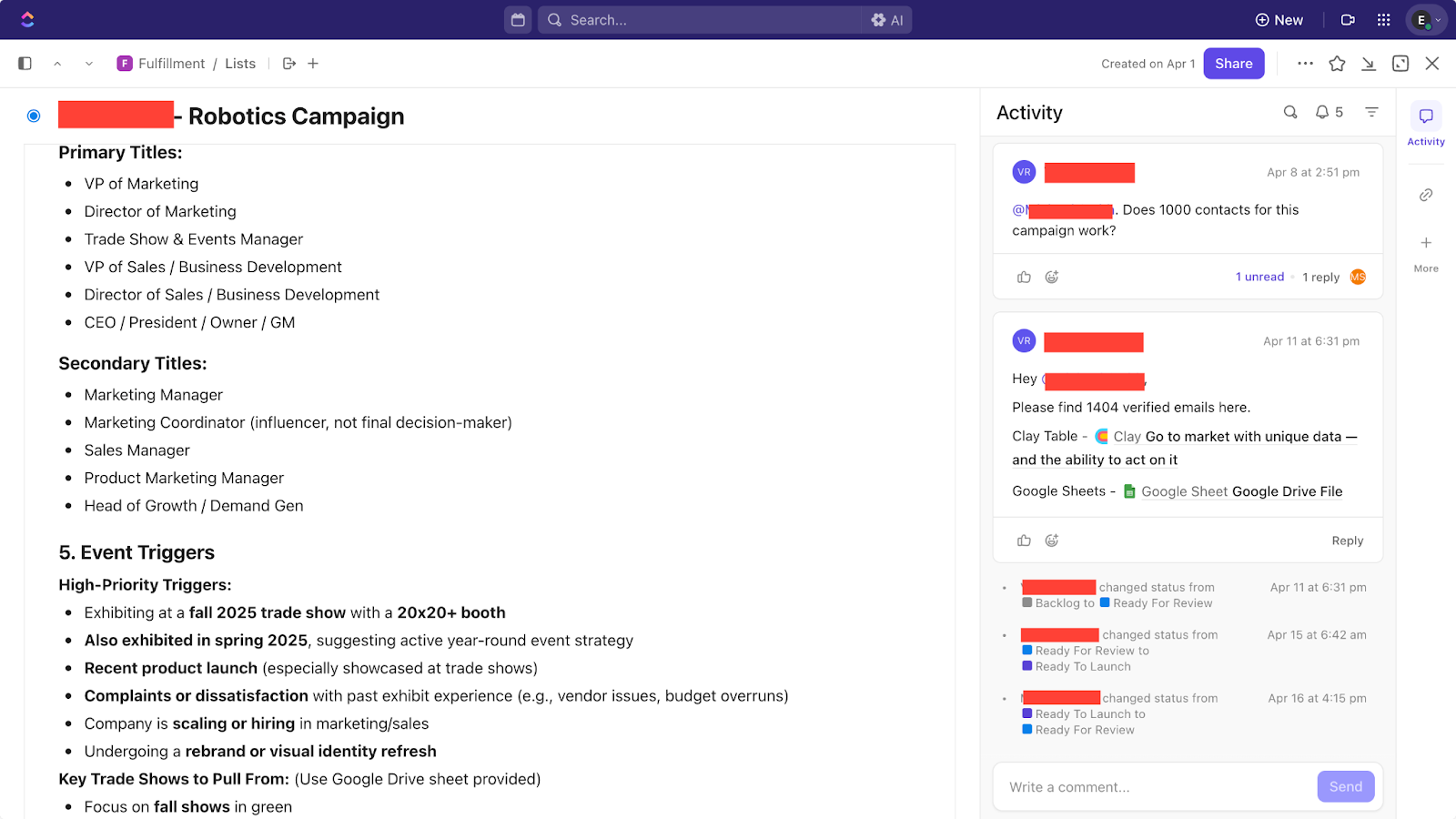
We flip the model. Our list builders go straight to the source: LinkedIn Sales Navigator, Apollo, Crunchbase, niche directories — anywhere our client’s buyers actually live. We vet every contact manually, confirm ICP fit, and build highly targeted lists.
Then — and only then — we move the list into Clay. That’s where we enrich it with intelligent signals: job changes, recent funding, role-specific keywords, expansion news, tech stack insights. These signals power the personalization that makes our campaigns stand out — and land meetings.
3. Our copy isn’t just personalized. It’s persuasive.
The biggest myth in cold email today? That “first name + company name + job title” counts as personalization.
Our approach is different. We write cold emails like sales reps — not like marketers. Every email we send is based on:
A buyer-specific pain point
A real-world trigger or insight
A hook that creates curiosity and urgency
Clear, conversational language that earns the reply
We don’t use templates. We don’t outsource to AI. Our messaging is crafted by in-house copywriters who’ve worked on seven-figure outbound campaigns and understand how to move skeptical buyers from “Not now” to “Tell me more.”
In one campaign targeting franchisors, our copy led to replies like:
“I like your attitude — you’re right. When can we talk?”
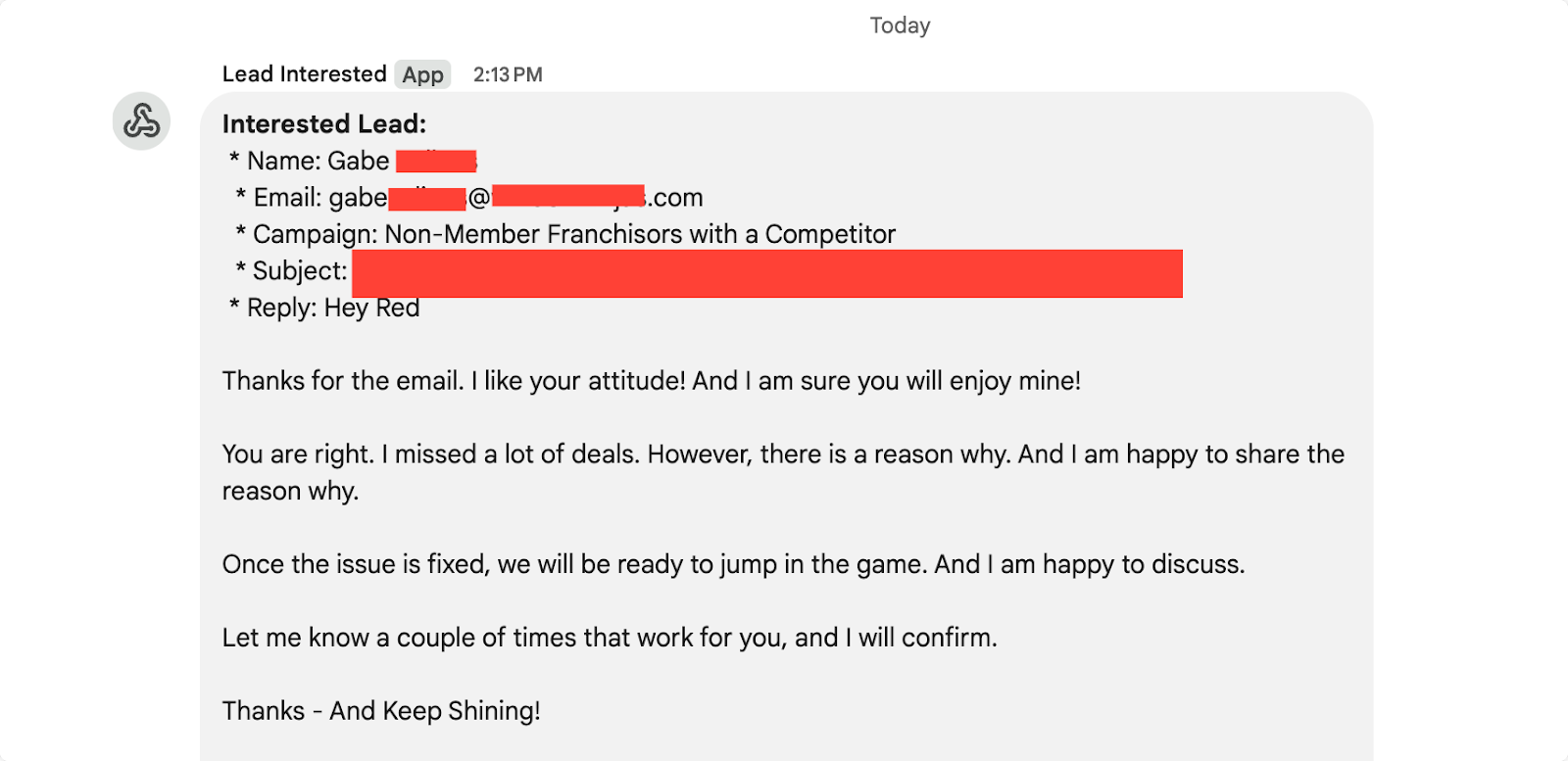
In another, targeting IT leaders in manufacturing:
“You nailed our pain point. Let’s hop on a call this week.”
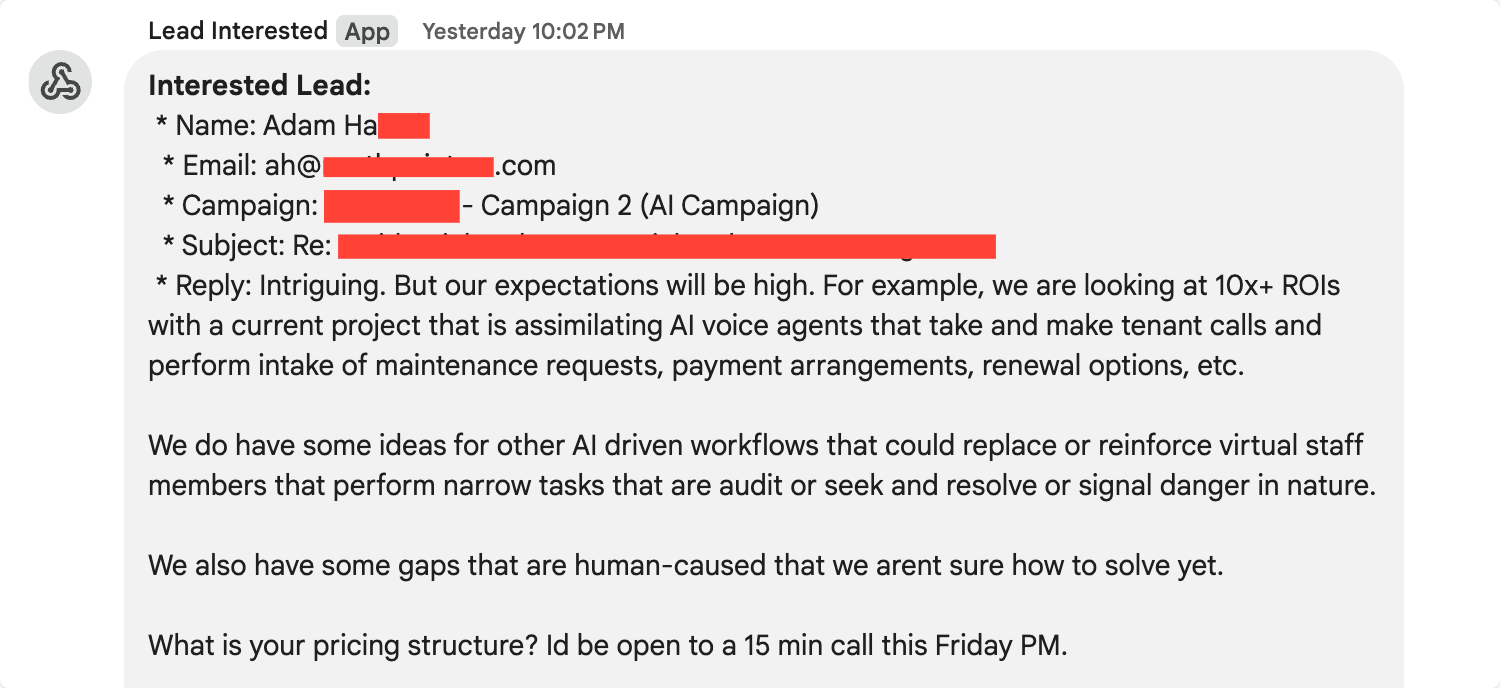
That’s the difference between an email that “looks good” and one that actually converts.
4. We engineer deliverability like it’s mission critical
Even the best copy won’t matter if your emails don’t reach the inbox.
That’s why we treat deliverability as a core competency — not a checkbox. We manage domain warm-up, SPF/DKIM/DMARC, email volume pacing, reply handling, and inbox trust signals down to the detail.
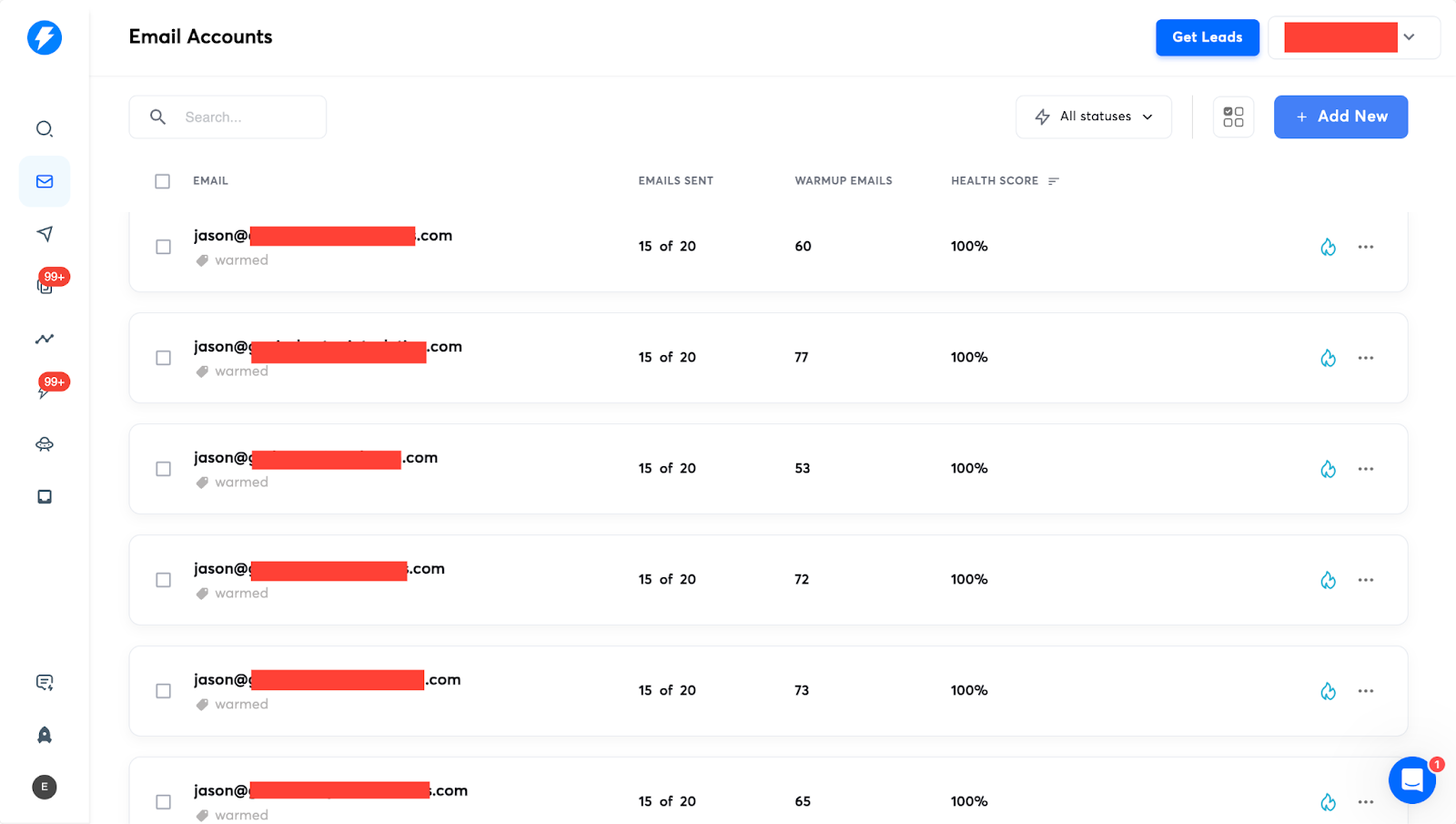
We’ve had clients come to us with inboxes that were getting <10% open rates. We cleaned up their technical setup, rewrote their email structure, rebuilt their sender reputation — and booked meetings the same week.
5. We guarantee meetings — and we back it up
We’re one of the only SDR agencies that backs our campaigns with a clear, no-loopholes meeting guarantee.
If we commit to 15 qualified meetings in a quarter, we don’t stop until you get them. If we hit a rough patch (and yes, outbound has volatility), we communicate it early, adapt fast, and keep working until we’re back on track.
This isn’t a side hustle for us. It’s our reputation — and we treat it like yours is on the line too.
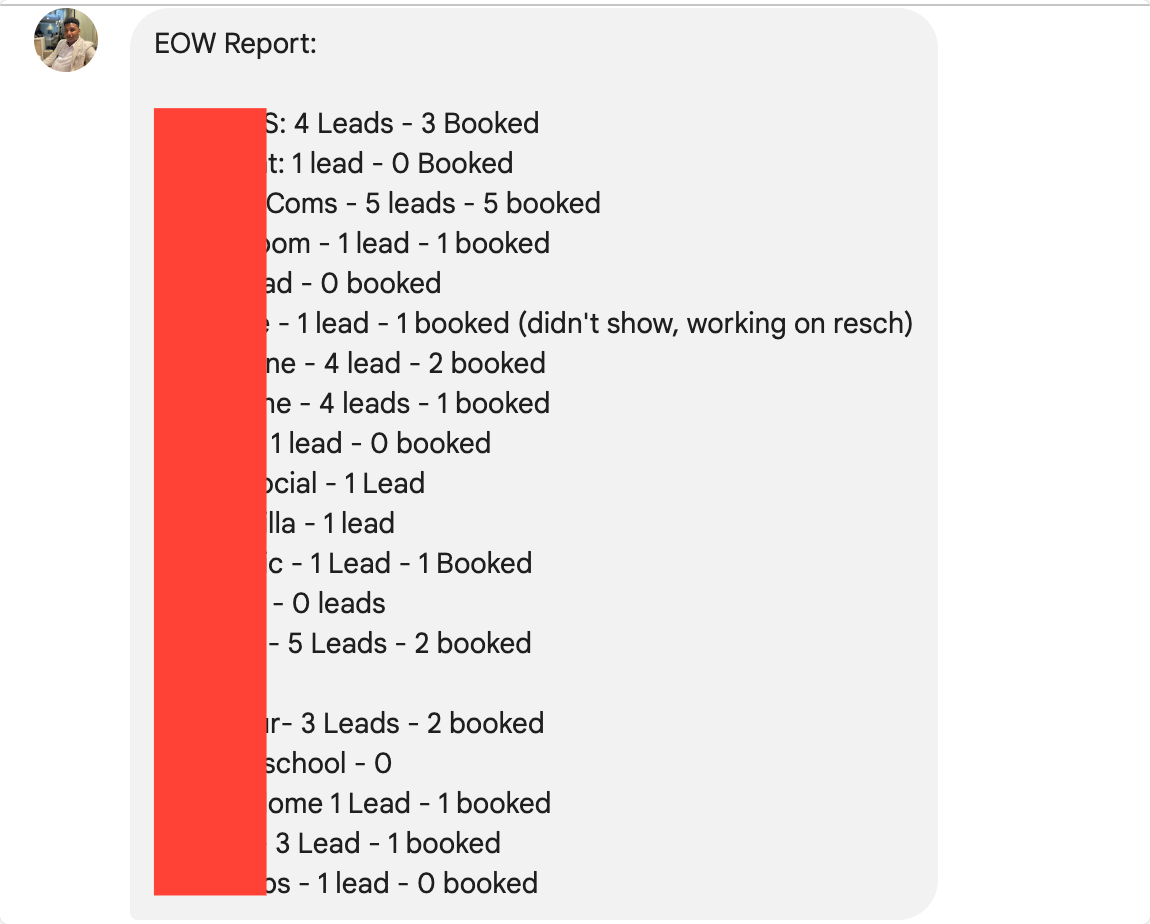
Real clients. Real results.
We’ve generated:
$12M in revenue for an AI data startup by reworking their ICP, offer, and message
$530K in 90 days for a podcast ad company entering a brand-new market
$8.6M over 4.5 years for a franchise platform that needed structure and scalability
These aren’t vanity metrics. They’re real outcomes — driven by outbound done right.
And we’re not talking about one lucky campaign. These are repeatable, process-driven wins.
Like this one.

Or this one.

Week after week, quarter after quarter, we put qualified buyers on our clients' calendars. Some see 3–5 meetings per week. For $50K+ deals, that adds up quickly.
Note: If you’re looking for a partner that fills your calendar with sales-qualified meetings backed with a guarantee, SocialBloom is here to help. We’ll handle everything from end to end and you’ll only be notified when there’s a meeting. Book a consultation now.
Belkins — Best for companies seeking a strategic, full-funnel SDR partner
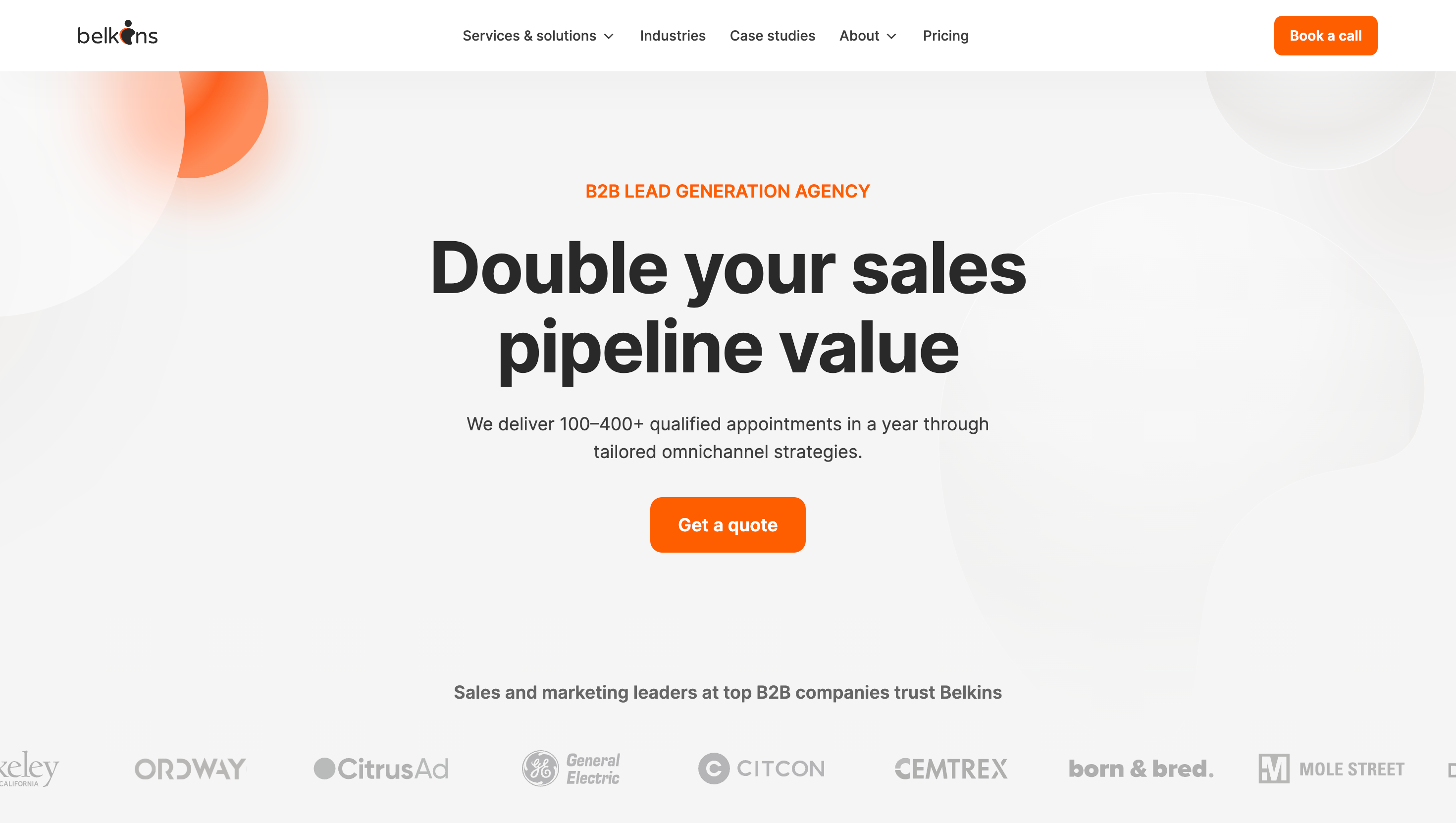
Belkins markets itself as more than just an appointment-setting firm—and in practice, that holds up. Their approach combines custom-built prospect databases, tailored messaging, and human-led outreach, with ongoing optimization baked into the engagement. You don’t just get SDRs on autopilot; you get a managed outbound system that adapts to your feedback and goals.
One of Belkins' biggest strengths is its onboarding and discovery process. They invest time in understanding your ICP, messaging nuances, and market dynamics. Their clients span industries like SaaS, healthcare, and financial services, and include big names like UC Berkeley and General Electric. That level of cross-vertical experience makes them a strong fit for mid-market and enterprise companies with more complex sales motions.
Where they may fall short: Belkins isn’t a plug-and-play provider. If you’re a seed-stage startup just looking to test outbound without much budget or messaging clarity, their strategic approach might feel like overkill—and the price point may reflect that. They’re built for companies who already have product-market fit and are ready to scale outbound as a core GTM channel.
Best fit for: Mid-market to enterprise B2B companies with longer sales cycles and complex ICPs.
Revit — Best for startups looking for predictable, low-risk outbound
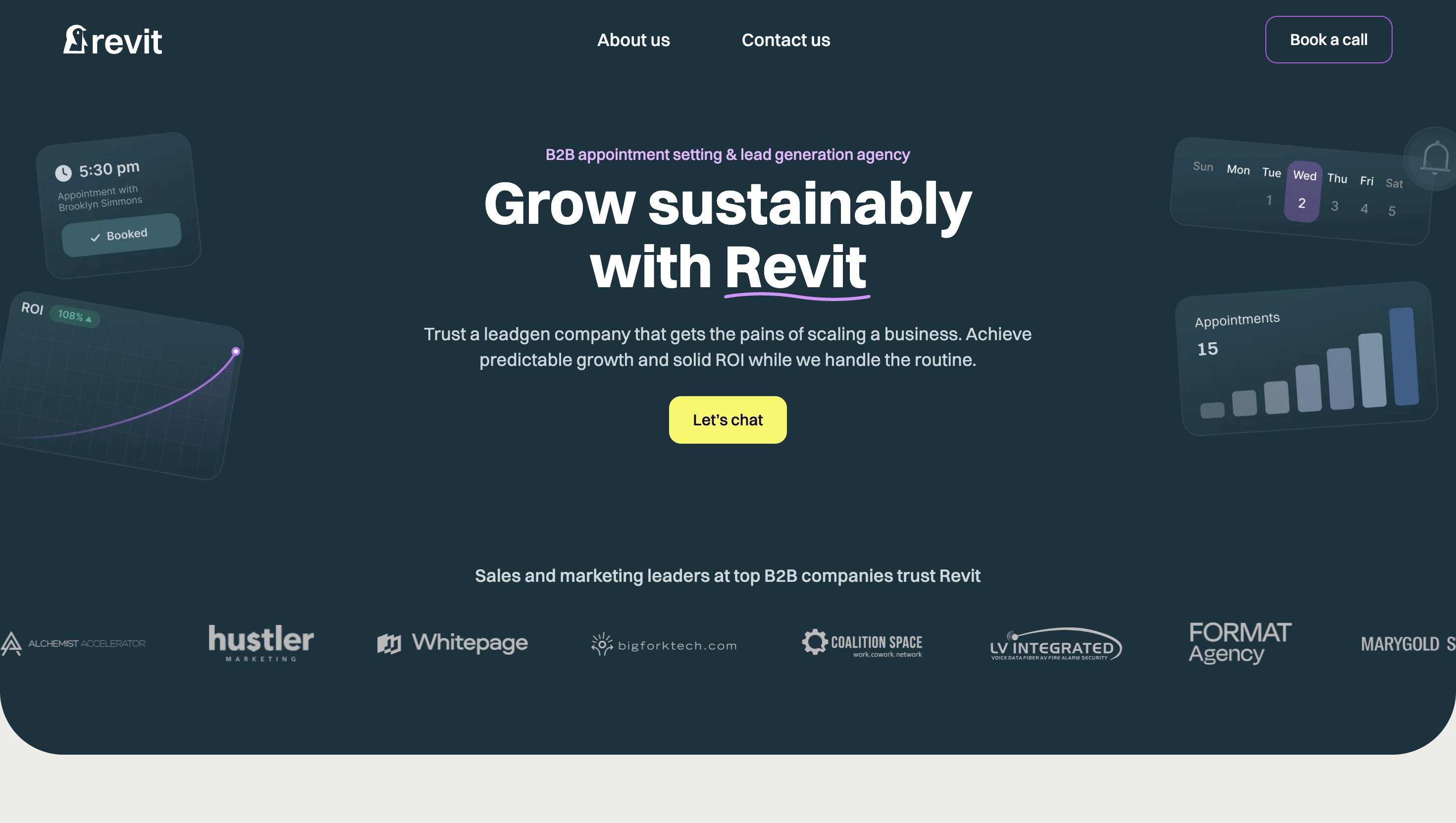
Revit is built for speed and simplicity. Their core pitch: pay-per-appointment, with a clear monthly subscription model that gives you the first five meetings, then charges per lead beyond that.
This structure appeals to early-stage startups or small teams trying to get outbound off the ground without investing in a fully managed, long-term engagement. Revit handles list-building, outreach, and booking, letting your internal team focus on closing.
The advantage here is predictability—you know exactly what you're getting, and you're not locked into high monthly retainers without results. It’s also ideal if you’re testing a new ICP or go-to-market strategy and want fast signal without heavy upfront investment.
Where they may fall short: Revit’s approach is transactional by design. That can work for simpler sales motions, but it also means less strategic collaboration, fewer customization layers, and potentially more variance in lead quality. If you have a niche ICP or highly technical product, you'll need to invest more in upfront training or risk mismatched meetings.
Best fit for: Seed to Series A startups that want quick outbound traction with minimal commitment.
Outbound Consulting — Best for companies transitioning from founder-led sales
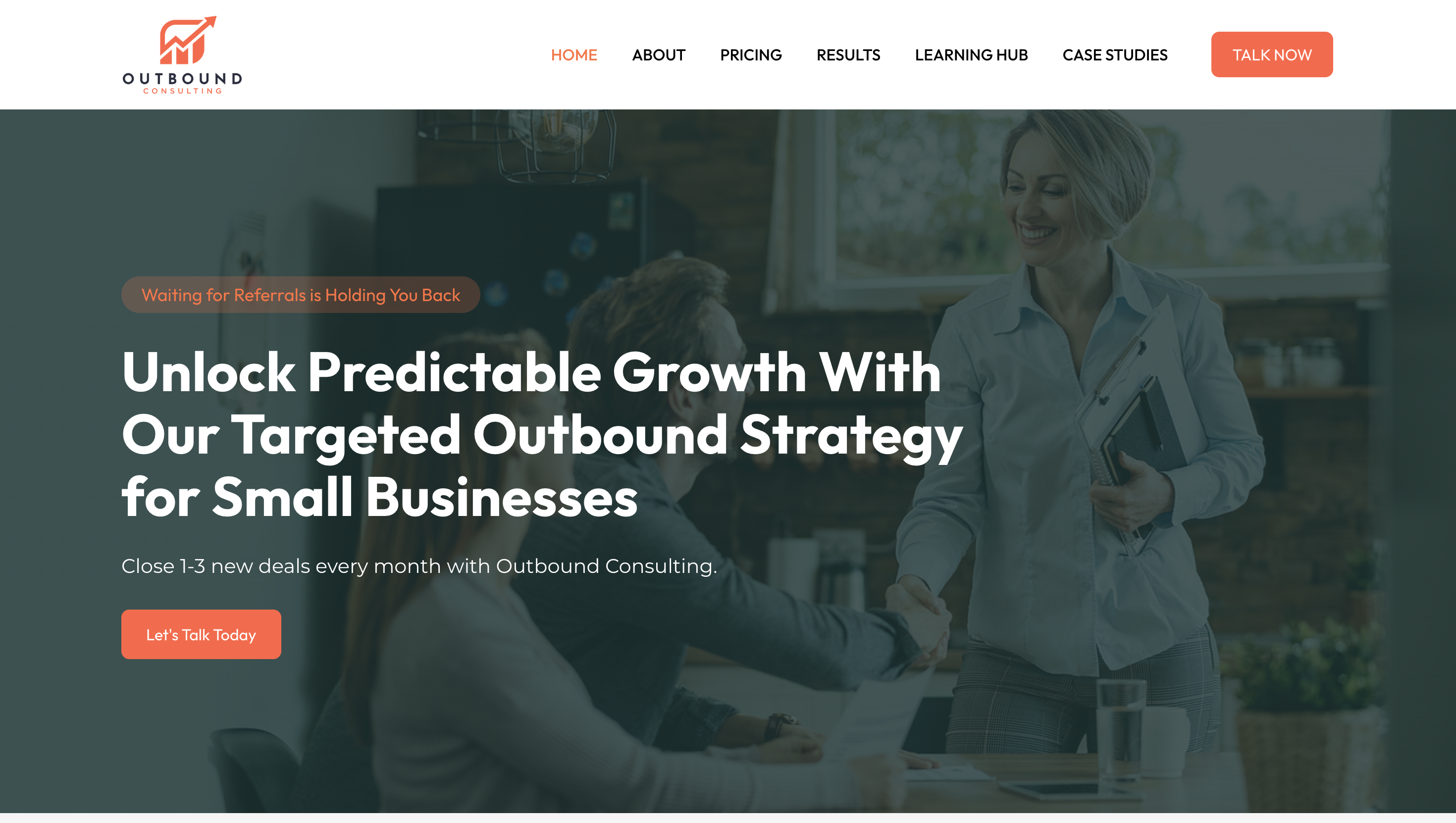
Outbound Consulting doesn’t try to be everything to everyone. They specialize in helping founders—especially in early-stage SaaS—graduate from doing all the selling themselves to building repeatable sales systems with SDR support.
They work hands-on to codify founder-led sales learnings into scalable outbound messaging and targeting strategies. This makes them especially effective for startups with high-touch, consultative sales cycles where the founder has deep market knowledge but no time to build or manage a sales team.
Unlike more transactional vendors, Outbound Consulting spends time capturing your tone, pitch, and strategic narrative so that outbound doesn’t feel like a disconnected channel. They often help bridge the gap between marketing and sales in organizations that haven’t fully built out either function yet. If you're considering B2B outsourced sales to improve efficiency, exploring leading companies in this space can be beneficial.
Where they may fall short: This is a boutique consultancy, not a high-volume SDR farm. If you’re looking to scale quickly or need 100+ meetings per quarter, they may not have the capacity or infrastructure to keep up. Their model is high-touch but lower throughput.
Best fit for: Early-stage SaaS companies moving from founder-led selling to structured outbound.
AltiSales — Best for B2B tech companies scaling outbound globally
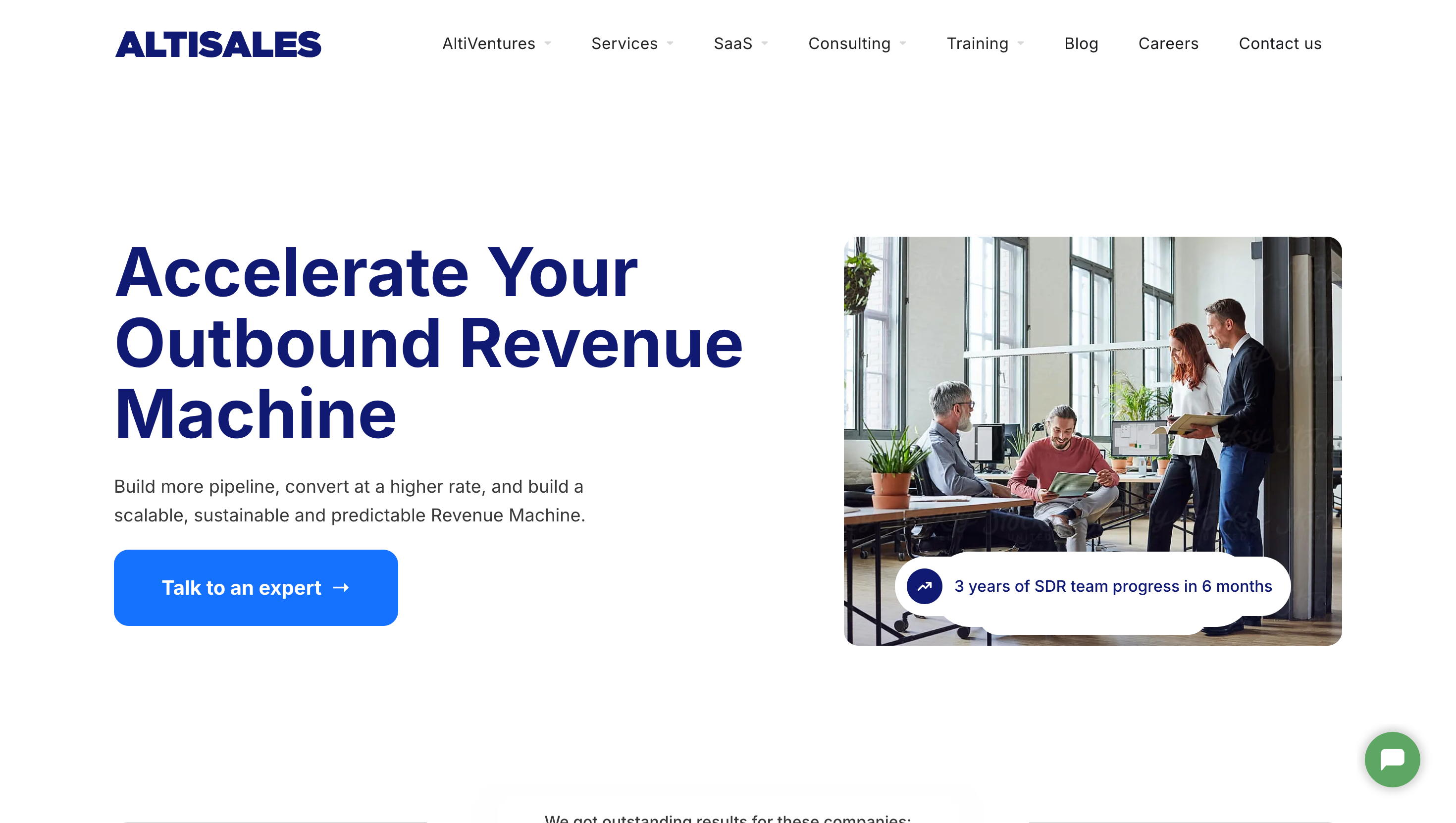
Founded by Tito Bohrt, AltiSales has carved out a niche as one of the most process-driven SDR outsourcing firms in the space. Their focus is clear: build elite SDR teams for B2B SaaS and tech companies, then support them with systems, training, and tooling.
AltiSales goes beyond appointment setting. They build playbooks, hire and manage SDRs, integrate with your RevOps stack, and continuously optimize based on performance. They’re known for treating outbound like a product—with regular iteration, metrics, and feedback loops.
They also emphasize global reach. With multilingual teams and international presence, AltiSales is especially valuable if you're expanding into new regions or selling to enterprise buyers across time zones.
Where they may fall short: You’re paying for rigor and quality—which means AltiSales typically isn’t the cheapest option. If you’re looking for a low-cost way to “just try outbound,” this likely isn’t your firm. They also require some GTM maturity; companies without a clear ICP or messaging strategy may struggle during onboarding.
Best fit for: Series B+ B2B SaaS companies looking to scale outbound across markets with a structured approach.
SalesRoads — Best for fast-growing companies needing instant SDR scale
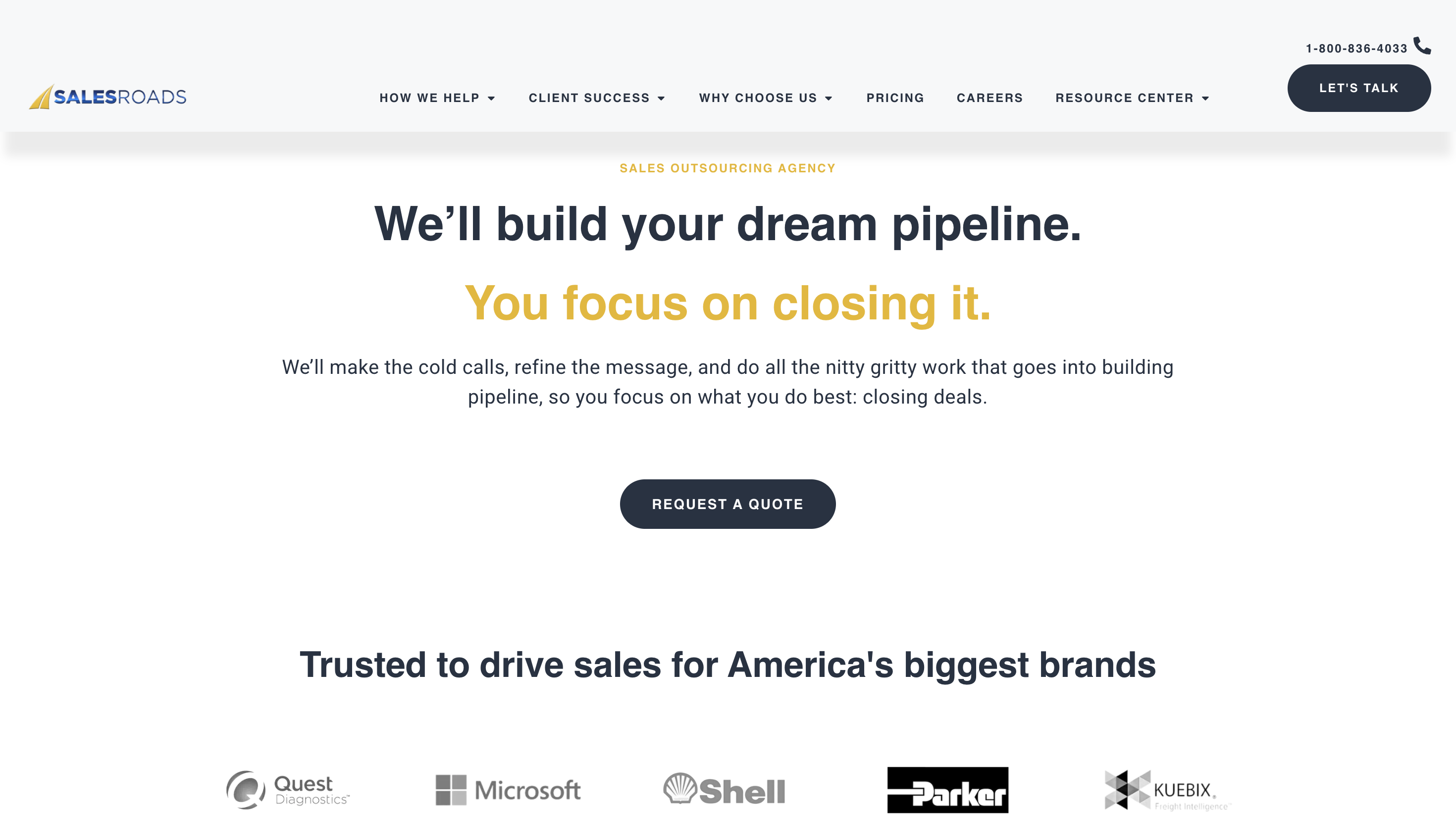
SalesRoads is one of the more established players in the U.S. outbound market, known for their fully managed SDR teams and focus on results. Their core value prop is speed—they can spin up a dedicated SDR team, complete with training and tech stack integration, in a matter of weeks.
Their process is tight: they handle everything from list-building to messaging to appointment setting, with regular reporting and performance reviews. If you’re looking to inject outbound horsepower into your funnel without building internally, SalesRoads makes that transition relatively seamless.
They’re especially strong in industries like IT services, SaaS, and consulting, and their ability to scale quickly makes them a go-to for companies that just raised a round or need to hit aggressive pipeline targets fast.
Where they may fall short: SalesRoads’ model is designed for velocity. That’s great for scaling—but less ideal for niche markets or highly technical sales. Some clients have reported variability in SDR quality, particularly when asking for deep domain knowledge or custom messaging.
Best fit for: Growth-stage companies that need fast, scalable outbound with minimal ramp time.
Note: If you’re looking for a partner that fills your calendar with sales-qualified meetings backed with a guarantee, SocialBloom is here to help. We’ll handle everything from end to end and you’ll only be notified when there’s a meeting. Book a consultation now.
Outsourced SDR services –– FAQ
What is an SDR company?
An SDR (Sales Development Representative) company is an agency or external team that specializes in prospecting, qualifying leads, and booking meetings for your sales team. Rather than expecting your internal reps to handle top-of-funnel activity alongside closing, an SDR company takes over that first critical step in the sales cycle. This allows your sales development team to focus more on converting qualified leads into customers while maintaining a full pipeline.
SocialBloom is an example of a high-performing outsourced SDR company. We handle the heavy lifting of lead generation, list-building, messaging, and outreach — and guarantee results. If your goal is to grow your sales pipeline without overloading your internal sales team, an SDR company can be a game-changer.
Who gets paid more, BDR or SDR?
The answer depends on the industry and company size, but generally speaking, compensation for Business Development Representatives (BDRs) and Sales Development Representatives (SDRs) is similar. However, BDRs who are responsible for outbound prospecting and closing smaller deals may earn more due to commission structures tied to revenue.
At SocialBloom, our outsourced SDRs work closely with our clients’ sales teams to ensure that handoffs are clean and that every qualified lead is one step closer to closing. This collaborative model often mirrors the alignment you’d see between BDRs and AEs in an in-house setup.
What is outsourced direct sales?
Outsourced direct sales is when a company partners with an external agency to manage some or all of its sales efforts. This includes generating leads, prospecting, qualifying potential customers, and setting appointments.
It’s a popular option for companies that want to scale quickly without hiring and training an internal sales team. SocialBloom’s model of outsourced SDR services goes beyond task execution. We integrate into your sales process, build custom strategies, and focus on delivering meetings with qualified leads.
Do SDRs work remotely?
Yes, most SDRs today work remotely. Remote sales development has become the norm thanks to tools like Clay, Instantly, and CRM systems that allow full visibility and collaboration.
At SocialBloom, our outsourced SDR team is fully remote and globally distributed. This enables 24/7 prospecting, flexibility across time zones, and a wider range of coverage for tech companies and B2B clients alike. With the right systems in place, remote SDRs are just as effective—if not more—than in-house reps.
How much does outsourced BDR cost?
The cost of outsourced BDR or SDR services can vary widely depending on the agency’s experience, the scope of work, and how many leads or meetings are guaranteed.
Basic services can start at $2,500/month, while more advanced outsourced SDR services (like SocialBloom's) that include strategy, list building, campaign management, copywriting, deliverability management, and booked meetings typically range from $5,000 to $12,000/month. The ROI, however, is measured not in vanity metrics but in booked calls and qualified leads that push your sales cycle forward.
What are the biggest IT outsourcing companies?
Some of the biggest IT outsourcing companies globally include Tata Consultancy Services (TCS), Accenture, IBM, Infosys, and Cognizant. These companies offer a wide range of technology services, including cloud infrastructure, enterprise software development, and support for advertising technology industries.
If you’re specifically looking for an outsourced sales agency for the IT space, SocialBloom has worked with enterprise-level technology companies to build outbound programs that deliver consistent results and qualified leads.
How to find outsourcing companies in the USA?
To find reliable outsourcing companies in the USA, start by clearly defining your goals—whether it's SDR outsourcing services, sales development consulting, or general sales outsourcing. Then evaluate agencies based on case studies, client testimonials, industry fit, and whether they take ownership of the outcome.
If you’re researching SDR outsourcing companies, SocialBloom stands out as a top-tier sales development partner. We offer personalized SDR outsourcing services tailored to your target market and sales objectives, with guarantees on performance and clear ROI.
What is the biggest outsourcing company?
The biggest outsourcing company in the world is often considered to be Accenture, with hundreds of thousands of employees worldwide and services spanning IT, operations, finance, and sales.
While Accenture dominates in scale, niche providers like SocialBloom dominate in focus. We don’t try to do everything. We specialize in outbound SDR services and outsourced sales development—designed to help B2B companies close deals, hit their sales goals, and drive business growth without bloated infrastructure.
Note: If you’re looking for a partner that fills your calendar with sales-qualified meetings backed with a guarantee, SocialBloom is here to help. We’ll handle everything from end to end and you’ll only be notified when there’s a meeting. Book a consultation now.